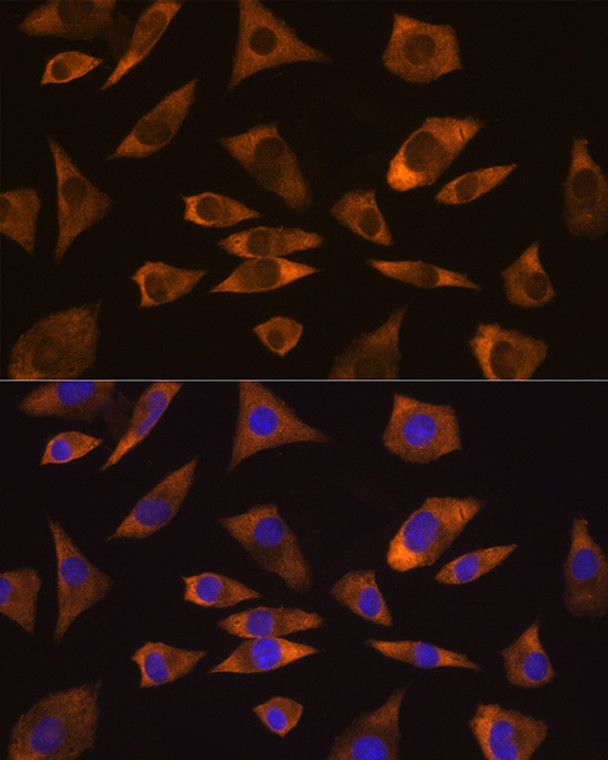| Host: |
Rabbit |
| Applications: |
WB/IF |
| Reactivity: |
Human/Mouse/Rat |
| Note: |
STRICTLY FOR FURTHER SCIENTIFIC RESEARCH USE ONLY (RUO). MUST NOT TO BE USED IN DIAGNOSTIC OR THERAPEUTIC APPLICATIONS. |
| Short Description: |
Rabbit polyclonal antibody anti-CAPRIN1 (1-709) is suitable for use in Western Blot and Immunofluorescence research applications. |
| Clonality: |
Polyclonal |
| Conjugation: |
Unconjugated |
| Isotype: |
IgG |
| Formulation: |
PBS with 0.05% Proclin300, 50% Glycerol, pH7.3. |
| Purification: |
Affinity purification |
| Dilution Range: |
WB 1:1000-1:5000IF/ICC 1:50-1:200 |
| Storage Instruction: |
Store at-20°C for up to 1 year from the date of receipt, and avoid repeat freeze-thaw cycles. |
| Gene Symbol: |
CAPRIN1 |
| Gene ID: |
4076 |
| Uniprot ID: |
CAPR1_HUMAN |
| Immunogen Region: |
1-709 |
| Immunogen: |
Recombinant fusion protein containing a sequence corresponding to amino acids 1-709 of human CAPRIN1 (NP_005889.3). |
| Immunogen Sequence: |
MPSATSHSGSGSKSSGPPPP SGSSGSEAAAGAGAAAPASQ HPATGTGAVQTEAMKQILGV IDKKLRNLEKKKGKLDDYQE RMNKGERLNQDQLDAVSKYQ EVTNNLEFAKELQRSFMALS QDIQKTIKKTARREQLMREE AEQKRLKTVLELQYVLDKLG DDEVRTDLKQGLNGVPILSE EELSLLDEFYKLVDPERDMS LRLNEQYEHASIHLWDLLEG KEKPVCGTTYKVLKEIVER |
| Tissue Specificity | Ubiquitous. |
| Post Translational Modifications | Tyrosine phosphorylation by EPHA4 promotes interaction with FMR1 and liquid-liquid phase separation (LLPS) for the formation of a membraneless compartment that concentrates mRNAs with associated regulatory factors. O-glycosylated (O-GlcNAcylated), in a cell cycle-dependent manner. O-glycosylation by OGT inhibit ability to undergo liquid-liquid phase separation (LLPS). |
| Function | mRNA-binding protein that acts as a regulator of mRNAs transport, translation and/or stability, and which is involved in synaptic plasticity in neurons and cell proliferation and migration in multiple cell types. Acts as an mRNA regulator by mediating formation of some phase-separated membraneless compartment: undergoes liquid-liquid phase separation upon binding to target mRNAs, leading to assemble mRNAs into cytoplasmic ribonucleoprotein granules that concentrate mRNAs with associated regulatory factors. Undergoes liquid-liquid phase separation following phosphorylation and interaction with FMR1, promoting formation of cytoplasmic ribonucleoprotein granules that concentrate mRNAs with factors that inhibit translation and mediate deadenylation of target mRNAs. In these cytoplasmic ribonucleoprotein granules, CAPRIN1 mediates recruitment of CNOT7 deadenylase, leading to mRNA deadenylation and degradation. Binds directly and selectively to MYC and CCND2 mRNAs. In neuronal cells, directly binds to several mRNAs associated with RNA granules, including BDNF, CAMK2A, CREB1, MAP2, NTRK2 mRNAs, as well as to GRIN1 and KPNB1 mRNAs, but not to rRNAs. |
| Protein Name | Caprin-1Cell Cycle-Associated Protein 1Cytoplasmic Activation- And Proliferation-Associated Protein 1Gpi-Anchored Membrane Protein 1Gpi-Anchored Protein P137Gpi-P137P137gpiMembrane Component Chromosome 11 Surface Marker 1Rna Granule Protein 105 |
| Cellular Localisation | CytoplasmCytoplasmic Ribonucleoprotein GranuleCytosolCell ProjectionDendriteLamellipodiumMediates Formation And Localizes To Cytoplasmic Ribonucleoprotein Membraneless CompartmentsAssociated With Rna GranulesAt The Leading Edge Of Migrating FibroblastsColocalizes With Ddx3x |
| Alternative Antibody Names | Anti-Caprin-1 antibodyAnti-Cell Cycle-Associated Protein 1 antibodyAnti-Cytoplasmic Activation- And Proliferation-Associated Protein 1 antibodyAnti-Gpi-Anchored Membrane Protein 1 antibodyAnti-Gpi-Anchored Protein P137 antibodyAnti-Gpi-P137 antibodyAnti-P137gpi antibodyAnti-Membrane Component Chromosome 11 Surface Marker 1 antibodyAnti-Rna Granule Protein 105 antibodyAnti-CAPRIN1 antibodyAnti-GPIAP1 antibodyAnti-GPIP137 antibodyAnti-M11S1 antibodyAnti-RNG105 antibody |
Information sourced from Uniprot.org
12 months for antibodies. 6 months for ELISA Kits. Please see website T&Cs for further guidance














